This week, a friend named Wendy invited me to speak with a group of first-time marathoners that she coaches. I decided that I would talk about what helped me manage running 25km for 17 days in Africa: how I stayed strong, how I managed the heat and how I dealt with setbacks. Another friend asked me to do the same with our school’s hockey team in September. I coach 2 teams myself so figured I should capture my musings for future use. Here goes.
The Heat
It was really hot in The Gambia. Like between 37 and 42 degrees hot. But the heat never impacted my running performance because I chose not to let it. The heat just was. I needed to run whether or not it was hot so I just didn’t think about it.
Sometimes after I explain this, people will say, “oh, so the heat wasn’t that bad.” I explain that that wasn’t it at all. It was very hot; 42 degrees is very hot. It’s 107.6 degrees Fahrenheit. It was so hot that my hair and skin were often dry despite sweating like crazy. The heat would dry the sweat right away. It was so hot that 2 pairs of my sneakers melted because the air temperature was so hot and because the heat made the asphalt so hot.
I couldn’t do anything about the heat. I had a 25km goal each day, regardless of the air temperature. I had no control over the heat. But I did have control over how I responded to and dealt with the heat. I coped with the heat by not even considering the heat. I never, ever considered that the heat might cause me to stop running because there was so way I was going to stop running. Stopping was never in the realm of options.
Managing 42 degree heat was all about being strong. The human body will allow you to be strong enough if you will it to be strong enough.
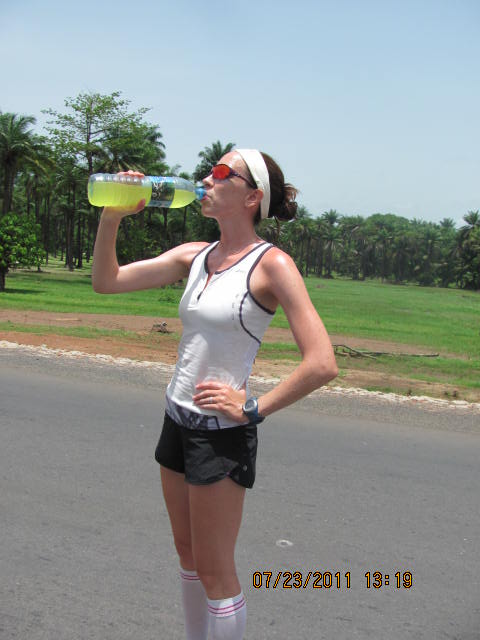 I was also doing everything possible to allow my body to run well in the heat. I was super careful with nutrition and had a team of 4 incredibly caring people keeping tabs on how much I was eating and drinking. I was drinking 5 litres of fluid over 25km of running; 3L of it was gatorade. I weighed myself before and after every run to make sure my hydration plan was sufficient. If you’ve ever tried to push 5 litres into your stomach, you know that it’s a lot! But it was what was required to survive and run so that’s what I did.
I was also doing everything possible to allow my body to run well in the heat. I was super careful with nutrition and had a team of 4 incredibly caring people keeping tabs on how much I was eating and drinking. I was drinking 5 litres of fluid over 25km of running; 3L of it was gatorade. I weighed myself before and after every run to make sure my hydration plan was sufficient. If you’ve ever tried to push 5 litres into your stomach, you know that it’s a lot! But it was what was required to survive and run so that’s what I did.
The rest of the day, back at our base camp (where ever that may be) was very very hot. I would shower and put on underwear/pajamas instead of clothes. My whole team was wearing underwear instead of clothes. If I wanted to, say, braid my hair and take out my contact lenses, I would have to separate these activities by 5 minutes because it was too hot to do them back-to-back.
If your race is hot, be smart, drink water and be assured that the human body can survive in the heat if you choose to be strong enough to survive.
Familiarity Breeds Comfort
In one of my favorite running blogs, “The Logic of Long Distance,” blogger Jeff writes:
“Familiarity breeds comfort, and though I feel pain, I get better at controlling my reaction to it.”
This was a very true phenomenon on the road to Banjul.
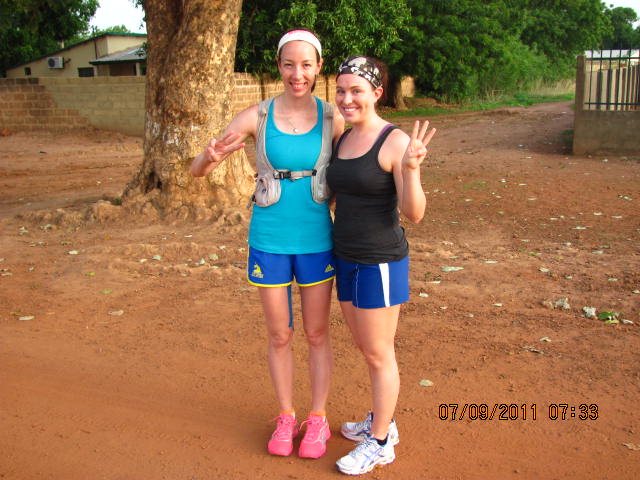
In my assessment, the worst that I felt was beginning the first 20km run on Day 3. It was my 3rd day of running 25km per day. I had put 50km on my legs in the past 48 hours. When I began to run that day, I was stiff and sore from toes to hips. And my shoulders ached from being in runner’s stride for so many hours out of the previous 48. Although that morning, I knew that the stiffness and soreness would fade within 2 or 3km as my forward running motion circulated fresh blood to my objecting muscles. I did feel better. By km 3, I was running comfortably.
Insightful blogger Jeff also writes:
“Long distance running requires endurance, by which we mean the ability to suffer.”
Looking back, although I name Day 3 as the worst day for my legs, I think that I actually felt like that every single day. But from Day 3 on I expected it; I was prepared for it; I knew it would go away; and I knew that I would run through it no matter what.
It was never dangerous pain. I hurt in an acceptable way. My legs were fatigued from hard work. I never had any “oh shit” injured parts. Some mornings, I would still be sore at km 2 so we would run until 15 minutes passed and then we would do a full set of track warm up drills and I would feel better after that.
I also helped my team run through expected discomfort. None of my teammates, Ashley, Pa Modou, Kebba and Spider, had ever run like this before: day after day after day. I helped them accept that there would be pain. I helped them embrace it, get past it and get on with it.
In fact, I almost had it easier than my teammates did. I was never going to give up and get into the truck. But Pa, Ashley, Kebba and Spider always had the option of getting back into the support truck. They had to be strong against a voice that I never had to deal with. The voice that whispers “Look at the truck, all nice and run-free. Don’t you want to stop and get into the truck?” My team stayed very strong next to me for many, many kilometers.
By Day 13, my quads and hip flexors were tired and remained tired until we reached the ocean. And by Day 13, I was sore at rest pretty much all the time but it was a happy, hard work sore and I just accepted it.
From Day 3 on, I couldn’t sleep in my favorite position because my legs refused to bend in bed. By Day 13, it became impossible to find a comfortable position for my legs in bed and those legs exacted their revenge on their owner by preventing sleep. I would rely on sleeping pills at night. Although it’s not fair to blame the sleeping pill reliance purely on leg soreness. Sleeping pills were also important because it was often 32 degrees at night with no electricity and no fan.
All of the discomfort that I felt on the road to Banjul was both familiar and expected and I knew that I wasn’t putting myself or my muscles in danger so we would continue running each day. The human body can do it.
During your marathon, be prepared to receive messages from your body and your brain. These messages will tell you: “We are tired. We hurt. We want to stop.” Be prepared to deal with these messages and push through it. Has this happened to you in training? Good! It’ll breed familiarity. Hold onto that experience as evidence that you can get through it.
Managing Setbacks: Figure out what works
Setbacks pop up. You have no control over them. I wouldn’t even call them “unexpected setbacks” because setbacks are expected. I ran 25km for 17 days and honestly, the remarkable days were the ones that were unremarkable. These were the days where all parts of the runner’s body and the team were smooth.
I managed a number of obstacles:
- On Day 6, kilometer markers appeared on the South Bank Road, announcing that I was 280km fromBanjul, filling me with waves of anxiety about how far I had to run.
- On Day 7, my setback was emotional, not physical. I was my birthday and I was lonely and missed my family
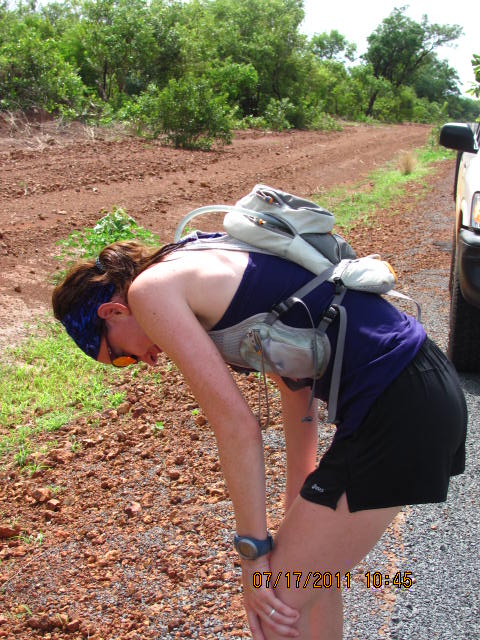 On Day 9, I poisoned myself with water from a tap and had terrible cramping diarrhea and couldn’t take a lot of gatorade or gels. It was hot and I was getting weak.
On Day 9, I poisoned myself with water from a tap and had terrible cramping diarrhea and couldn’t take a lot of gatorade or gels. It was hot and I was getting weak.
- On Day 13, Ashley was sick in bed and the rest of the team was down. I had an intense and persistent “I don’t want to run” feeling. Part of my brain was trying desperately to hit the “off” switch to cease running operation.
- On Day 14, I didn’t want to run. I knew that I would do it, I just didn’t want to.
- On Day 15, we didn’t have enough food and I was hungry. We were in place that food was hard to get. I was cranky. Then my breasts chafed really badly. Then our destination disappeared and I had to run an unexpected extra 5km pushing my daily total to 30km while hungry with a chafed chest.
- On Day 16, we ran 6km down the yellow centre line in the middle of the highway, surrounded by insane, angry traffic
I managed all of these setbacks. On the 2 days I was ill, I knew that when the run ended, I could recover by eating and sleeping the rest of the day. I knew that I wasn’t physically harming myself by running through it so I pushed through it by being strong.
When my breasts chafed, I hurt a lot. I knew that I couldn’t give in to hurting. If I knew that if I could focus enough, I could get the pain under my sports bra to go away. If I can focus hard enough on just running, I have the ability to just run and tune everything else out. So that’s what I did.
Focus got me through my emotional setbacks too. On Day 7, I told Kebba (who was running next to me) that I wasn’t going to talk to him for the next 20 minutes. “I’m not happy or sad, I’m just running,” I told him. Kebba replied, “That’s ok, I have many exciting thoughts in my head!” I zoned out and just ran. I made my mind go blank. Running was all I was focused on. And I recovered.
On Day 13 when I didn’t want to run, I used my “rope.” My team loved my saying to tie a figurative rope to the runner next to you and let him/her pull you along. That day, I looked at the kids who were running with us and I tied my rope around them and I did it.
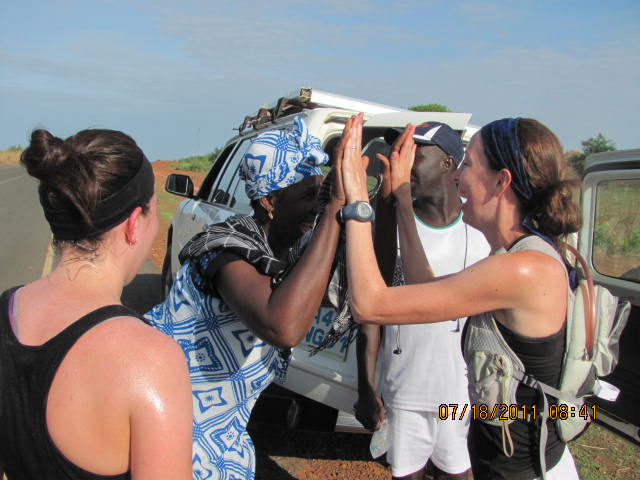 The kids, mamas and soldiers were hugely helpful for my team and me. My legs matched my mood out there on the road in The Gambia. Like I said, we often hurt or were tired. But each time we were joined by children and youth, all traces of fatigue and pain vanished. We were running for these kids, for NSGA programs that impact their lives. With them running next to us, we felt like we could fly. When a convoy of soldiers saluted me, it was impossible not to have my spirit soar. When my spirit soared, so did my legs. When 70 year old Mamas in rice fields hugged me, high fived me, laughed with me, expressed their gratitude to me, I would run away from them with legs that felt brand new.
The kids, mamas and soldiers were hugely helpful for my team and me. My legs matched my mood out there on the road in The Gambia. Like I said, we often hurt or were tired. But each time we were joined by children and youth, all traces of fatigue and pain vanished. We were running for these kids, for NSGA programs that impact their lives. With them running next to us, we felt like we could fly. When a convoy of soldiers saluted me, it was impossible not to have my spirit soar. When my spirit soared, so did my legs. When 70 year old Mamas in rice fields hugged me, high fived me, laughed with me, expressed their gratitude to me, I would run away from them with legs that felt brand new.
Recognize that if you run long enough, setbacks will happen and some struggle is inevitable. I’m not suggesting that my exact strategies will work for you. I discovered that they worked for me by paying attention to my training and learning what helps when I struggle. So pay attention to what works and put that in the pocket of your short shorts for use when you need it.
Now if your race is in North America and not on the South Bank Road in The Gambia, you may not be quite a lucky as I was. But there are a lot of joyful sights on the sidelines of a North American race. There are people cheering. There are volunteers spending their day with you, handing you water. There are police officers holding back traffic and recognizing your effort with a smile. There are folks who have put effort into coloring signs. Your friends and family may be there. Think about what you’ll find on the race course and plan to use these small pieces of joy to lighten your feet. If you tell yourself it’s going to work, it might just work.
Mantras
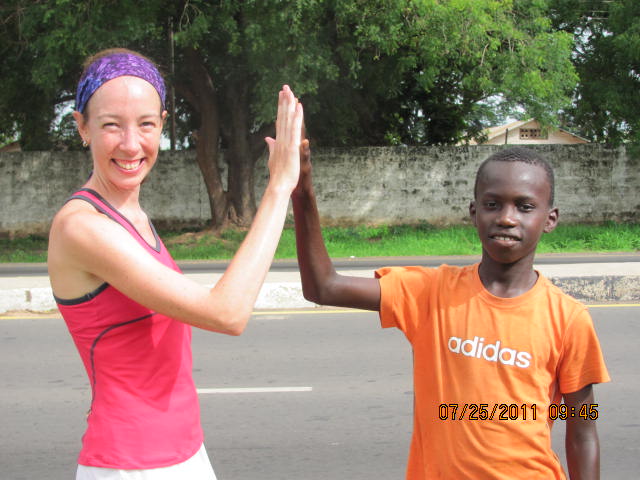
I have used mantras during many races- a short sentence repeated over and over again. It helps me push the sensory data from my legs out of my head. I concentrate only on the words. On Day 16, my legs were tired and while I wasn’t injured, of course I was hurting. A young boy, Molamin was running with us. I was watching him run and saying to myself, “Run for him. Run for him.” During the 9km he ran with us, I remember feeling like I hurt everywhere and nowhere all at once. My mantra made those 9km disappear easily.
Sometimes I have prepared mantras and sometimes they just pop into my head like “run for him” on Day 16. My aunty Debby sent Team Love4Gambia a message every single day and her mantra was “Do your best and the forget the rest.” I like that one.
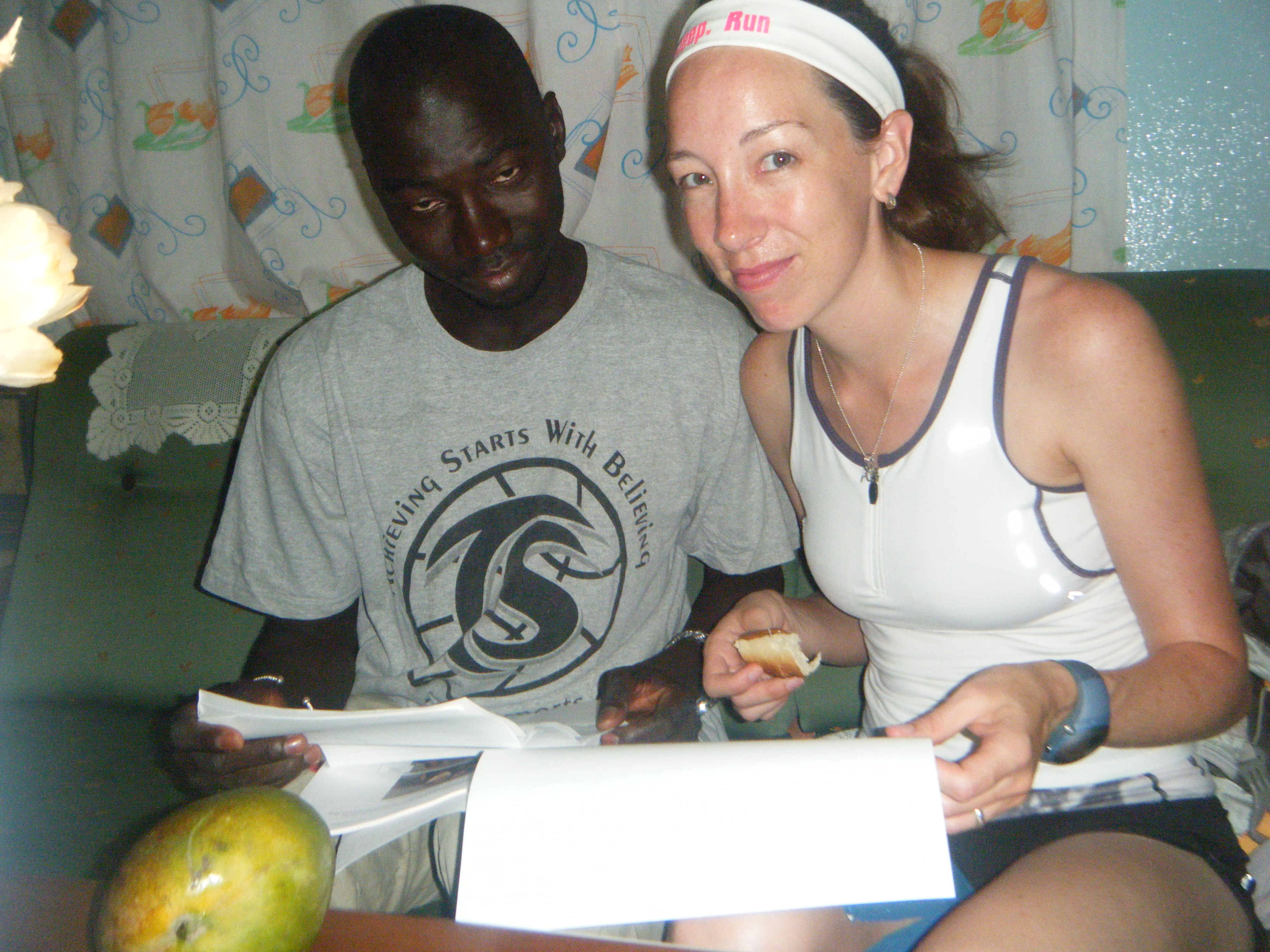
My self-proclaimed “number one fan” 10 year old Kate Keast wrote me a motivation saying for each of the 17 days that we ran. One of them resonated particularly well with me and I repeated it to myself often: “Don’t put pressure on yourself. Just do your best and the best will happen.” I loved this one and loved that it came from my sweet little Kate, a girl wise and caring beyond her years.
Believing in Yourself and Dealing with People
Don’t ever let anyone tell you that you can’t or that you are crazy. Well, you don’t have control over what people say to you. But don’t ever believe it!
A LOT of people thought that we were crazy and that we would never make it toBanjul. These people lived in both Canada and The Gambia. But we made it together because we always, always believed that we would make it.
A lot of people in The Gambia could not believe that a woman could do this. And they frequently told me so. Heck, people sometimes didn’t even believe that I was a woman. Ashley and I were on the Gambian news and people would approach us and say to Ashley: “I saw you and that man on tv.” Spider’s friends saw us running on Day 16, with their own eyes, and quizzed him after: “are you sure that’s a woman? Have you seen her body parts?” I proved these people wrong every single day.
I coach high school runners and tell them:
“the only person who can tell you that you can’t is yourself.”
I gave this advice to myself in The Gambia. I gave this advice to my teammates who had never run this long, this far or this much in their lives. And I successfully coached these runners to run 110km (Ashley), 118km (Spider), 137km (Pa Modou) and 250km (Kebba) next to me.
Recognize that the people telling you that you are crazy are often inactive, spend too much time sitting on the couch, follow a poor diet and are putting themselves at risk for a lifetime of chronic health problems. They are the crazy ones.
Maybe some of this is helpful, maybe not. It helped me and my team accomplishment a huge and amazing goal. At the end of the day, I’m not an overly special or talented runner. I’m not an elite or a professional. I am just a regular girl with some talent who worked really hard for 7 months to prepare for a really difficult challenge. I was determined to reach my goal no matter what.
I wish you the same determination.

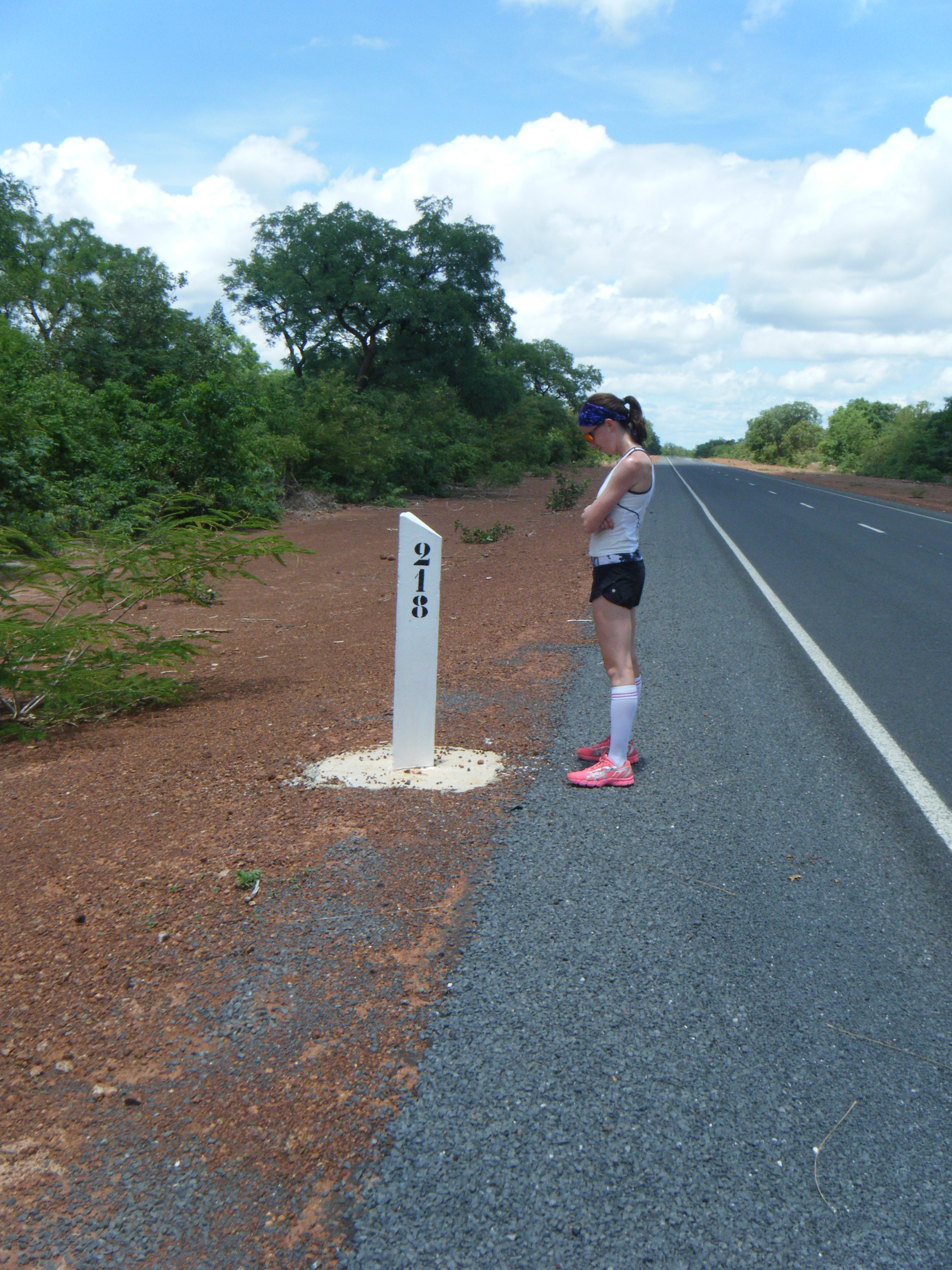

6 Responses
Great post Erin! You do such a great job of describing your journey in a way that people can relate. I never get tired of hearing about your journey 🙂 Congrats again.
Erin
Once again I read your post “gambia” blogs and I am truly proud to say that I know you. You are a true inspiration, to myself, and the many people that you have touched and will continue to touch. Your words are written with such passion, devotion, and confidence. I can almost imagine the “pain” both physical and emotional, that you endured…yet you did it!! Not only for the people of Gambia but now for the people of your own community. I am so proud of you.
Thanks for making me feel not so crazy after all:)
Keep telling your story. You continue to make a difference. 🙂